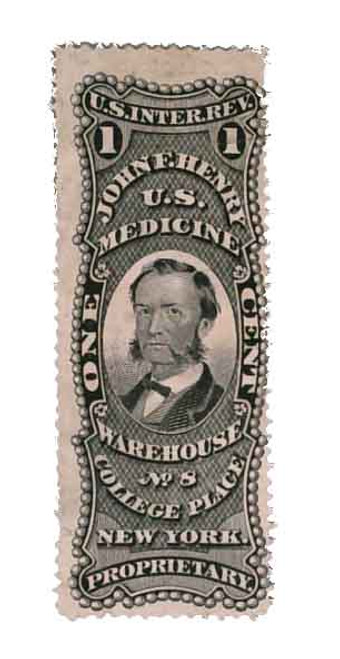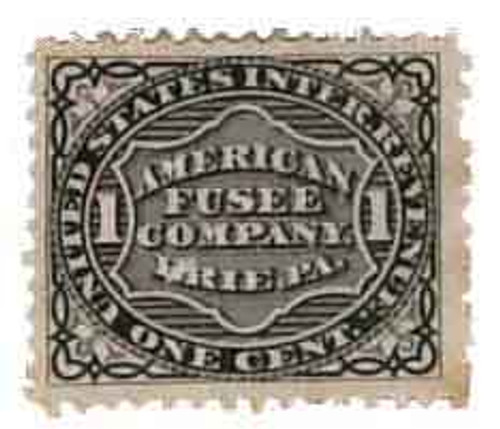
# RS114c - 1877-78 1c black, pink paper
US #RS114c
1869-83 John F. Henry Private Die Medicine Tax Stamp
• Covered the Proprietary Tax rate for medicine
• Produced by John F. Henry of College Place, New York
• Printed on pink paper – no one knows exact quantity produced, but many were destroyed in the process of use, making them scarce today
Stamp Category: Private Die Proprietary Tax Stamp
Company Using the Die: John F. Henry US Medicine Warehouse of College Place, New York
Value: 1¢ Medicine Tax
First Day of Issue: October 1869 (last issued February 27, 1883)
Quantity Issued: 1,254,444 (this is the total number of stamps printed on pink and watermarked paper, no one knows for sure exactly how many were printed on each)
Type: Pink paper
Color: Black
Why the stamp was issued: To cover the 1¢ tax to be paid on medicine.
About the stamp design: Pictures an elaborate frame design with crosshatching and other ornamentation surrounding a portrait of a man (presumably John Henry himself). Text on the stamp reads “U.S. Inter. Rev.,” “John F. Henry,” “U.S. Medicine Warehouse,” “No. 8 College Place New York,” “Proprietary,” “One Cent.”
History the stamp represents: The United States issued its first Revenue stamps in 1862 to help fund the Civil War (although the stamps continued to be issued long after the war ended). This included Proprietary Tax stamps covering taxes on medicines, matches, perfumes, and much more. The taxes required for each different type of item were laid out in Schedule C of the 1862 Tax Act.
Later on, the federal government began offering tax discounts to manufacturers who produced their own Proprietary Tax stamps. The manufacturers paid for the engraving and printing expenses while the printing dies were controlled and approved by the US Department of the Treasury. Since each individual company determined the design of their stamps, they often used them as miniature advertisements for their products.
John F. Henry was born into the J.M. Henry & Sons proprietary medicine firm in 1850’s Vermont. He moved out on his own in 1865 and began working for Demas Barnes in New York (originally at 8 College Place in New York City, the building was renamed 24 in 1880). When Barnes left the business in 1868, Henry took over as owner/operator. At first, he was able to use Barnes’ old Private Die Proprietary Tax stamps, but by 1869, he had run out. He ordered his own stamp designs that same year in 1¢, 2¢, and 4¢ values.
The 1¢ black stamp was first issued in October 1869 and last issued February 27, 1883. In all, 451,000 were printed on old paper, 1,855,676 on silk paper, and 1,254,444 on pink and watermarked papers.
US #RS114c
1869-83 John F. Henry Private Die Medicine Tax Stamp
• Covered the Proprietary Tax rate for medicine
• Produced by John F. Henry of College Place, New York
• Printed on pink paper – no one knows exact quantity produced, but many were destroyed in the process of use, making them scarce today
Stamp Category: Private Die Proprietary Tax Stamp
Company Using the Die: John F. Henry US Medicine Warehouse of College Place, New York
Value: 1¢ Medicine Tax
First Day of Issue: October 1869 (last issued February 27, 1883)
Quantity Issued: 1,254,444 (this is the total number of stamps printed on pink and watermarked paper, no one knows for sure exactly how many were printed on each)
Type: Pink paper
Color: Black
Why the stamp was issued: To cover the 1¢ tax to be paid on medicine.
About the stamp design: Pictures an elaborate frame design with crosshatching and other ornamentation surrounding a portrait of a man (presumably John Henry himself). Text on the stamp reads “U.S. Inter. Rev.,” “John F. Henry,” “U.S. Medicine Warehouse,” “No. 8 College Place New York,” “Proprietary,” “One Cent.”
History the stamp represents: The United States issued its first Revenue stamps in 1862 to help fund the Civil War (although the stamps continued to be issued long after the war ended). This included Proprietary Tax stamps covering taxes on medicines, matches, perfumes, and much more. The taxes required for each different type of item were laid out in Schedule C of the 1862 Tax Act.
Later on, the federal government began offering tax discounts to manufacturers who produced their own Proprietary Tax stamps. The manufacturers paid for the engraving and printing expenses while the printing dies were controlled and approved by the US Department of the Treasury. Since each individual company determined the design of their stamps, they often used them as miniature advertisements for their products.
John F. Henry was born into the J.M. Henry & Sons proprietary medicine firm in 1850’s Vermont. He moved out on his own in 1865 and began working for Demas Barnes in New York (originally at 8 College Place in New York City, the building was renamed 24 in 1880). When Barnes left the business in 1868, Henry took over as owner/operator. At first, he was able to use Barnes’ old Private Die Proprietary Tax stamps, but by 1869, he had run out. He ordered his own stamp designs that same year in 1¢, 2¢, and 4¢ values.
The 1¢ black stamp was first issued in October 1869 and last issued February 27, 1883. In all, 451,000 were printed on old paper, 1,855,676 on silk paper, and 1,254,444 on pink and watermarked papers.











